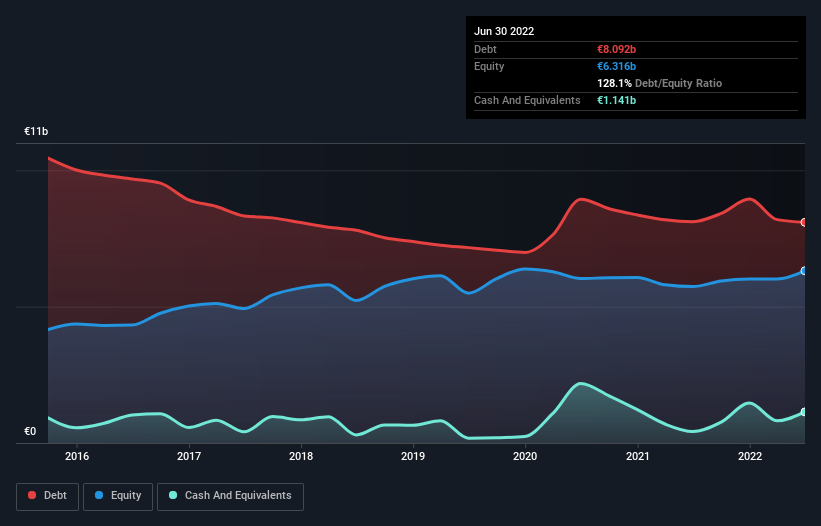
The external fund manager backed by Berkshire Hathaway's Charlie Munger, Li Lu, makes no bones about it when he says 'The biggest investment risk is not the volatility of prices, but whether you will suffer a permanent loss of capital.' So it seems the smart money knows that debt - which is usually involved in bankruptcies - is a very important factor, when you assess how risky a company is. As with many other companies Aena S.M.E., S.A. (BME:AENA) makes use of debt. But the more important question is: how much risk is that debt creating?
When Is Debt Dangerous?
Debt assists a business until the business has trouble paying it off, either with new capital or with free cash flow. Part and parcel of capitalism is the process of 'creative destruction' where failed businesses are mercilessly liquidated by their bankers. However, a more usual (but still expensive) situation is where a company must dilute shareholders at a cheap share price simply to get debt under control. Having said that, the most common situation is where a company manages its debt reasonably well - and to its own advantage. The first thing to do when considering how much debt a business uses is to look at its cash and debt together.
View our latest analysis for Aena S.M.E
How Much Debt Does Aena S.M.E Carry?
The chart below, which you can click on for greater detail, shows that Aena S.M.E had €8.09b in debt in June 2022; about the same as the year before. However, it does have €1.14b in cash offsetting this, leading to net debt of about €6.95b.

How Strong Is Aena S.M.E's Balance Sheet?
The latest balance sheet data shows that Aena S.M.E had liabilities of €1.92b due within a year, and liabilities of €7.49b falling due after that. Offsetting these obligations, it had cash of €1.14b as well as receivables valued at €992.1m due within 12 months. So its liabilities outweigh the sum of its cash and (near-term) receivables by €7.27b.
This deficit isn't so bad because Aena S.M.E is worth a massive €17.0b, and thus could probably raise enough capital to shore up its balance sheet, if the need arose. However, it is still worthwhile taking a close look at its ability to pay off debt.
In order to size up a company's debt relative to its earnings, we calculate its net debt divided by its earnings before interest, tax, depreciation, and amortization (EBITDA) and its earnings before interest and tax (EBIT) divided by its interest expense (its interest cover). Thus we consider debt relative to earnings both with and without depreciation and amortization expenses.
With a net debt to EBITDA ratio of 5.1, it's fair to say Aena S.M.E does have a significant amount of debt. However, its interest coverage of 6.1 is reasonably strong, which is a good sign. We also note that Aena S.M.E improved its EBIT from a last year's loss to a positive €604m. When analysing debt levels, the balance sheet is the obvious place to start. But it is future earnings, more than anything, that will determine Aena S.M.E's ability to maintain a healthy balance sheet going forward. So if you want to see what the professionals think, you might find this free report on analyst profit forecasts to be interesting.
Finally, a business needs free cash flow to pay off debt; accounting profits just don't cut it. So it is important to check how much of its earnings before interest and tax (EBIT) converts to actual free cash flow. During the last year, Aena S.M.E generated free cash flow amounting to a very robust 95% of its EBIT, more than we'd expect. That puts it in a very strong position to pay down debt.
Our View
When it comes to the balance sheet, the standout positive for Aena S.M.E was the fact that it seems able to convert EBIT to free cash flow confidently. However, our other observations weren't so heartening. To be specific, it seems about as good at managing its debt, based on its EBITDA, as wet socks are at keeping your feet warm. It's also worth noting that Aena S.M.E is in the Infrastructure industry, which is often considered to be quite defensive. Considering this range of data points, we think Aena S.M.E is in a good position to manage its debt levels. But a word of caution: we think debt levels are high enough to justify ongoing monitoring. When analysing debt levels, the balance sheet is the obvious place to start. However, not all investment risk resides within the balance sheet - far from it. Case in point: We've spotted 1 warning sign for Aena S.M.E you should be aware of.
Of course, if you're the type of investor who prefers buying stocks without the burden of debt, then don't hesitate to discover our exclusive list of net cash growth stocks, today.
New: Manage All Your Stock Portfolios in One Place
We've created the ultimate portfolio companion for stock investors, and it's free.
• Connect an unlimited number of Portfolios and see your total in one currency
• Be alerted to new Warning Signs or Risks via email or mobile
• Track the Fair Value of your stocks
Have feedback on this article? Concerned about the content? Get in touch with us directly. Alternatively, email editorial-team (at) simplywallst.com.
This article by Simply Wall St is general in nature. We provide commentary based on historical data and analyst forecasts only using an unbiased methodology and our articles are not intended to be financial advice. It does not constitute a recommendation to buy or sell any stock, and does not take account of your objectives, or your financial situation. We aim to bring you long-term focused analysis driven by fundamental data. Note that our analysis may not factor in the latest price-sensitive company announcements or qualitative material. Simply Wall St has no position in any stocks mentioned.
About BME:AENA
Aena S.M.E
Engages in the management of airports in Spain, Brazil, the United Kingdom, Mexico, and Colombia.
Solid track record with adequate balance sheet.
Similar Companies
Market Insights
Community Narratives





